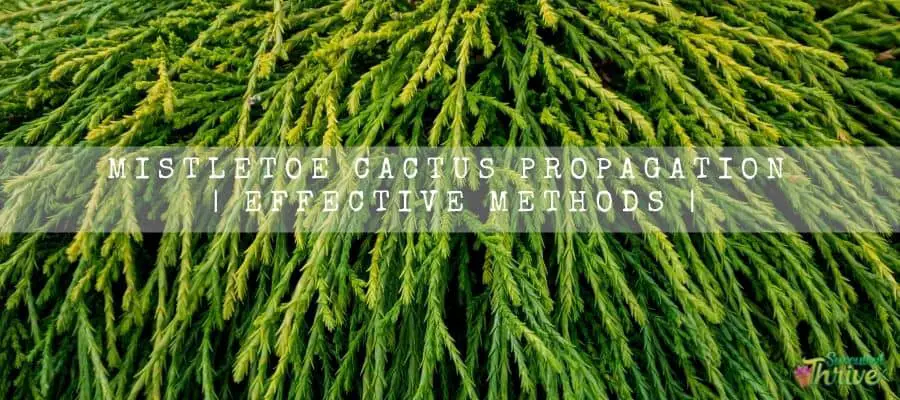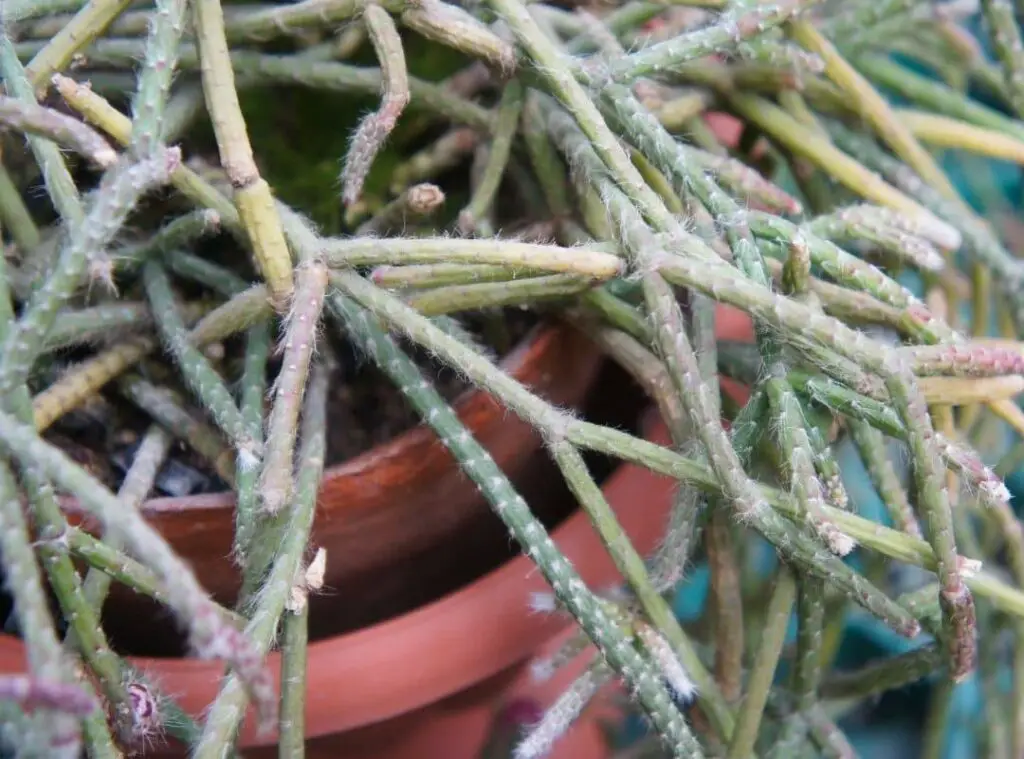Mistletoe cactus propagation is a very easy task. Here is a comprehensive detailed guide on how to conduct the propagation of Mistletoe cactus.

What is mistletoe cactus?
Mistletoe cactus (Rhipsalis baccifera) is a unique evergreen succulent. They grow as leafless plants, and many people tend to grow them as ornamental houseplants.
They would add so much grace no matter where you plant them, and it will bring a sense of freshness to your home.
They would be the highlight in your home particularly during the festive season as their prominent green color and the mistletoe fruits. It will intensify the Christmas spirit at your home.
Mistletoe cactus is an epiphytic cactus and somewhat different to other succulents and to the cactus general.
They have narrow stems which you could spot in pale green. They tend to take a pendant shape and reach a maximum height of 2 feet when they grow to the fullest. Furthermore, they produce flowers in creamy white color. Besides, they grow spineless and produce edible fruits.
The Mistletoe cactus fruits would tend to take a spherical shape and you could spot them either in white or flesh color. Those fruits have a sweet taste as well.
These plants require only an easy-care from you despite the different requirements they have in the light and in moisture when compared to other succulents.
Mistletoe cactus are considered as a symbol of fertility, long life, good health and even good luck as well.
Mistletoe cactus propagation by stem Cuttings
To start the proceedings, you need to first snip off the section of the stem of the plant and plant it in a container.
I recommend you use a well-draining soil mix so that you can rely on the successful results of the propagation.
Further the right planter needs to have sufficient draining holes too. You may water the container to make the soil moist and then place them exposed under bright and indirect sunlight.
You could see how they develop roots within four weeks’ time. In another several months, they will produce a fully developed root system.
You need to conduct the propagation during the growing season which literally means spring and summer.

Do they produce seeds?
Mistletoe cactus produce seeds and if you are a patient gardener, you can use them to propagate them as well.
Mistletoe cactus would first produce flowers and later they would transform into fruits. They will ripen and only then you can find the seeds.
To propagate them, you can plant them in moist seed starting mixture or even in a well-draining potting mix.
Can you root the mistletoe cactus in water?
You may propagate Mistletoe cactus in water. Here, they would grow in water instead of soil and the difference in the growing medium is the only change here.
It will be less messy, and many people find this method very interesting. However, the cutting should be about 10-15 cm in length.
How to treat after propagation
Light requirement of Mistletoe cactus.
Fulfilling the light requirement of the Mistletoe cactus is critical when looking after the plants after propagation.
These are not the type of plants which need bright sunlight. Instead, they would prefer to have filtered sunlight.
Never expose them to full sunlight for extended periods. Hence no matter where you plant them, you should always ensure that they get partial sunlight to full shade.
Fertilizer requirement of Mistletoe cactus.
Mistletoe cactus have minimal requirements when it comes to nutrients. Hence you may feed the Mistletoe cactus occasionally.
Occasional feeding will help the plants to grow healthily and vigorously. Best fertilizer to use for them would be half-diluted cactus food.
Further the best time to feed them would be from April to September, but only for one month only. Suspend applying fertilizers during their dormancy.

Soil requirement of Mistletoe cactus.
The key factor in the right soil mix should be the draining factor as it is critical for the optimal growth of these plants.
Do not leave them in soggy, damp waterlogged conditions as it will help to deteriorate the health of the plants.
Further in terms of the right pH of the soil mix it should ideally be slightly acidic. You can make a soil mix on your own by blending peat compost, and sterile sand.
Temperature requirement of Mistletoe cactus.
It is crucial that you grow them in really warmer temperatures.
They are tolerant of minimum temperatures around 60 degrees Fahrenheit ( 15 degrees Celsius). As such if you live in colder weather conditions, best is to grow them as houseplants.
Related questions
How do you root the mistletoe cactus cuttings?
You can take Mistletoe cactus stem cuttings to root them. All you need to do is to snip healthy looking stems from the plants and leave them in a warmer place to wither.
Next you can plant them in a pre-moistened soil mix. You can spot them developing roots within two to six weeks’ time.
Does a mistletoe cactus need sunlight?
Low to medium light levels would work well with these plants the best. Avoid exposing them to harsh direct sunlight.
How long does it take a mistletoe cactus to root?
It would take about two weeks to six weeks for a mistletoe cactus to root.
Conclusion
Mistletoe cactus would be handy as ornamental houseplants. Besides they could fit in for any indoor environment or for any exterior environment as well. They can grow well with minimum supervision from you too.
Read Next : Orchid Cactus Propagation | 4 Effective Methods | Ferocactus Pilosus Propagation ( The Only Method You Need ) Chandelier Plant Propagation | 4 Effective Methods |
